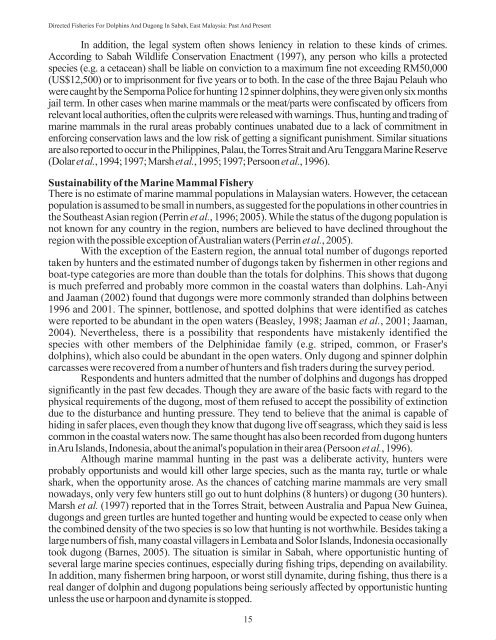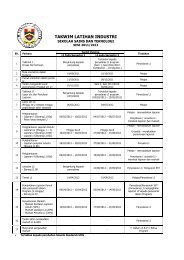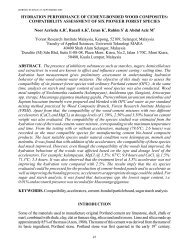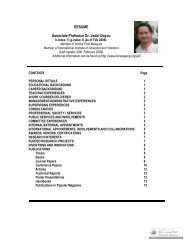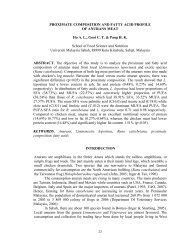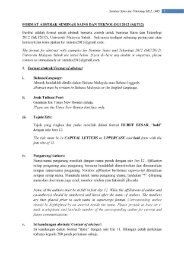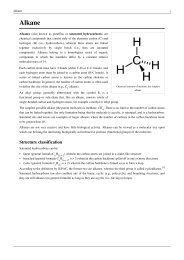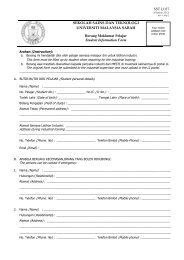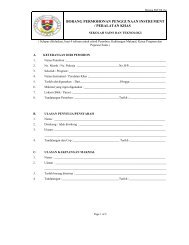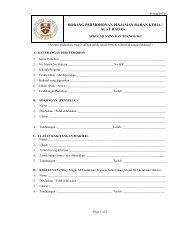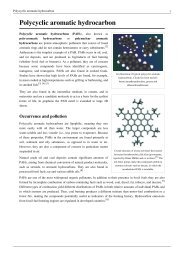Saifullah A. Jaaman, Yuhana U. Lah-Anyi & Graham J. PierceMagnitude of the Marine Mammal CatchesThe present study suggests that substantial numbers of dolphins and dugongs have been andprobably continue to be caught for human consumption in Sabah waters. Hunting in the pastwas a deliberate activity; however, currently there are very few hunters left and hunting is morean opportunistic activity during fishing trips. This new evidence supports the previoussuggestions made on the nature and magnitude of dolphin and dugong hunting in the SoutheastAsian region. Perrin et al. (1996) stated that directed catches for cetaceans in the SoutheastAsiaare restricted to what appear to be low levels of sporadic take of inshore species in several areas.However, they suggested that the extent is likely underestimated. Recently, Perrin et al. (2005)added that significant dugong catches, either intentionally or opportunistically, for subsistencepurposes are likely to continue in its range in the region.The results indicate that the magnitude of dugong catches in the past was similarthroughout Sabah, but significantly greater for dolphins in the Eastern and Northeasternregions than in the Western region. The present level of marine mammal hunting in the tworegions is still a serious cause for concern since there are significantly higher proportions ofrespondents that were not aware of government bans on catching marine mammals, ascompared to respondents in the Western region. The Eastern and Northeastern regions areapparently larger, less urbanised and a higher proportion of their populations do not receiveformal education, as compared to the Western region (TRPDS, 1998). This might explain whypeople there are less aware of laws and matters pertaining to environmental conservation.Fishermen using outboard- or pump-engines boats hunted both marine mammalspecies, whereas those using non-powered boats were able to hunt only dugongs. Pump boatswere preferred, being used by more than half of the fishermen, and the number of dolphinsreported to be killed is significantly higher for fishermen using pump boats than boats withoutboard-engines. Since pump boats are used by the majority of hunters in the Eastern andNortheastern regions, this could also explain the higher estimated catch of dolphins in theseregions, as compared to the Western region. Small to medium size pump boats are also used bycetacean hunters in the Philippines (Dolar et al. , 1994; 1997) and hunters in Lembata and SolorIslands, Indonesia, used nine- to fifteen-man sail or outboard-engine boats to hunt whales,dolphins and other large marine species (Barnes, 1991; 2005). Outboard-engine boats are alsoused by dugong hunters in the Torres Strait and Palau, while dugout canoes are used to huntdolphins and dugongs in the Solomon Islands (Takekawa, 2000) and Aru Islands, Indonesia(Persoon et al. , 1996), respectively.The results also indicate that harpoon/spear is the main gear used to hunt marine mammals.Although there is some difference in shape and operating method, the finding is consistent withother reports on marine mammal hunting in the region (Barnes, 1991; 2005; Dolar et al. , 1994;Persoon et al. , 1996). It is not illegal to carry a harpoon at sea, thus many fishermen keep it in theirboats and use it usually to kill sharks or turtles that are caught in their fishing gears. However, whenan opportunity arises, such as a dugong being spotted close by or incidentally caught in fishing net,they are most likely to use the harpoon to hunt/kill the animal. The use of dynamite to catch fish, isillegal, but sometimes it is also used to kill marine mammals. This home-made bomb, which usesfertiliser as it main component, has devastated many reef areas in Sabah and other parts of theSoutheastAsia and continues to be used, with a lack of commitment by the authorities to control itsusage (Perrin et al. , 2005; Oakley et al. , 2000).14
Directed Fisheries For Dolphins And Dugong In Sabah, East <strong>Malaysia</strong>: Past And PresentIn addition, the legal system often shows leniency in relation to these kinds of crimes.According to Sabah Wildlife Conservation Enactment (1997), any person who kills a protectedspecies (e.g. a cetacean) shall be liable on conviction to a maximum fine not exceeding RM50,000(US$12,500) or to imprisonment for five years or to both. In the case of the three Bajau Pelauh whowerecaughtbytheSempornaPoliceforhunting12spinnerdolphins,theyweregivenonlysixmonthsjail term. In other cases when marine mammals or the meat/parts were confiscated by officers fromrelevant local authorities, often the culprits were released with warnings.Thus, hunting and trading ofmarine mammals in the rural areas probably continues unabated due to a lack of commitment inenforcing conservation laws and the low risk of getting a significant punishment. Similar situationsarealso reported to occur in thePhilippines, Palau, theTorres StraitandAruTenggaraMarineReserve(Dolar etal. ,1994;1997;Marsh etal. ,1995;1997;Persoon etal. ,1996).Sustainability of the Marine Mammal FisheryThere is no estimate of marine mammal populations in <strong>Malaysia</strong>n waters. However, the cetaceanpopulation is assumed to be small in numbers, as suggested for the populations in other countries inthe SoutheastAsian region (Perrin et al. , 1996; 2005). While the status of the dugong population isnot known for any country in the region, numbers are believed to have declined throughout theregion with the possible exception ofAustralian waters (Perrin et al. , 2005).With the exception of the Eastern region, the annual total number of dugongs reportedtaken by hunters and the estimated number of dugongs taken by fishermen in other regions andboat-type categories are more than double than the totals for dolphins. This shows that dugongis much preferred and probably more common in the coastal waters than dolphins. Lah-Anyiand Jaaman (2002) found that dugongs were more commonly stranded than dolphins between1996 and 2001. The spinner, bottlenose, and spotted dolphins that were identified as catcheswere reported to be abundant in the open waters (Beasley, 1998; Jaaman et al. , 2001; Jaaman,2004). Nevertheless, there is a possibility that respondents have mistakenly identified thespecies with other members of the Delphinidae family (e.g. striped, common, or Fraser'sdolphins), which also could be abundant in the open waters. Only dugong and spinner dolphincarcasses were recovered from a number of hunters and fish traders during the survey period.Respondents and hunters admitted that the number of dolphins and dugongs has droppedsignificantly in the past few decades. Though they are aware of the basic facts with regard to thephysical requirements of the dugong, most of them refused to accept the possibility of extinctiondue to the disturbance and hunting pressure. They tend to believe that the animal is capable ofhiding in safer places, even though they know that dugong live off seagrass, which they said is lesscommon in the coastal waters now. The same thought has also been recorded from dugong huntersinAru Islands, Indonesia, about the animal's population in their area (Persoon et al. , 1996).Although marine mammal hunting in the past was a deliberate activity, hunters wereprobably opportunists and would kill other large species, such as the manta ray, turtle or whaleshark, when the opportunity arose. As the chances of catching marine mammals are very smallnowadays, only very few hunters still go out to hunt dolphins (8 hunters) or dugong (30 hunters).Marsh et al. (1997) reported that in the Torres Strait, between Australia and Papua New Guinea,dugongs and green turtles are hunted together and hunting would be expected to cease only whenthe combined density of the two species is so low that hunting is not worthwhile. Besides taking alarge numbers of fish, many coastal villagers in Lembata and Solor Islands, Indonesia occasionallytook dugong (Barnes, 2005). The situation is similar in Sabah, where opportunistic hunting ofseveral large marine species continues, especially during fishing trips, depending on availability.In addition, many fishermen bring harpoon, or worst still dynamite, during fishing, thus there is areal danger of dolphin and dugong populations being seriously affected by opportunistic huntingunless the use or harpoon and dynamite is stopped.15
- Page 5 and 6: BORNEO SCIENCE 23: SEPTEMBER 2008DI
- Page 7 and 8: Directed Fisheries For Dolphins And
- Page 9 and 10: Directed Fisheries For Dolphins And
- Page 11 and 12: Directed Fisheries For Dolphins And
- Page 13 and 14: Directed Fisheries For Dolphins And
- Page 15 and 16: Directed Fisheries For Dolphins And
- Page 17: Directed Fisheries For Dolphins And
- Page 21 and 22: Directed Fisheries For Dolphins And
- Page 23: Directed Fisheries For Dolphins And
- Page 27 and 28: Detecting Outliers By Using Trimmin
- Page 29 and 30: Detecting Outliers By Using Trimmin
- Page 31 and 32: BORNEO SCIENCE 23: SEPTEMBER 2008DE
- Page 33 and 34: Determination Of On-line Breakthrou
- Page 35 and 36: Determination Of On-line Breakthrou
- Page 37 and 38: Determination Of On-line Breakthrou
- Page 39 and 40: Determination Of On-line Breakthrou
- Page 41 and 42: Determination Of On-line Breakthrou
- Page 43 and 44: BORNEO SCIENCE 23: SEPTEMBER 2008GA
- Page 45 and 46: Gastrointestinal Protozoan Parasite
- Page 49: Gastrointestinal Protozoan Parasite
- Page 52 and 53: Zainodin, H. J. & Khuneswari, GY=
- Page 54 and 55: Zainodin, H. J. & Khuneswari, GThe
- Page 56 and 57: Zainodin, H. J. & Khuneswari, GTabl
- Page 58 and 59: Zainodin, H. J. & Khuneswari, GThe
- Page 60 and 61: Zainodin, H. J. & Khuneswari, GThet
- Page 62 and 63: Zainodin, H. J. & Khuneswari, GX 45
- Page 64 and 65: Zainodin, H. J. & Khuneswari, GNow
- Page 66 and 67: Zainodin, H. J. & Khuneswari, GMode
- Page 69 and 70:
BORNEO SCIENCE 23: SEPTEMBER 2008PE
- Page 71 and 72:
Penentuan Komponen Meruap Dalam Tig
- Page 73 and 74:
Penentuan Komponen Meruap Dalam Tig
- Page 75 and 76:
BORNEO SCIENCE 23: SEPTEMBER 2008WA
- Page 77 and 78:
Water Absorption And Curing Time Pe
- Page 79 and 80:
Water Absorption And Curing Time Pe
- Page 81 and 82:
BORNEO SCIENCE 23: SEPTEMBER 2008RE
- Page 83 and 84:
INSTRUCTIONS TO CONTRIBUTORS / AUTH
- Page 85 and 86:
BORNEO SCIENCE ORDER FORMI am inter
- Page 87:
BORNEO SCIENCEA JOURNAL OF SCIENCE


